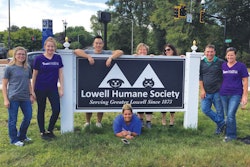
What does our industry look like in 20 years? Only recently I was asked this question. In times where looking ahead three years is already a challenge, doing so for 20 years is downright pretentious — because life cycles of trends become shorter, because market characteristics are changing rapidly, because we must stop taking things for granted. Nevertheless, thinking about the future of our industry is worth a try, and I will try so hereafter.
For the sake of argument I will make a distinction between what I see as macro trends and those that are more specific to our industry, which you might see as micro trends. (“Trend” being defined as consistent and coherent direction rather than fashion or hype.)
A 'New Renaissance' will bring trial and error for pet food
If we are aware that we are on the brink of entering the New Renaissance — and in some ways we have already entered it — we see a period of hugely intensified trial and error ahead of us. Making mistakes will be an accepted part of the game. Avoidance of risk is no longer seen as a social virtue.
This changing social context will bring new entrants to the industry; people not tainted by past “truths,” myths and ways to do things. On the contrary, it will be the (young) and industrious explorer who doesn’t know about pet food conventions, who is curious and constantly asks her/himself “why?” and “what if?” Individuals with tenacity who will not be satisfied with “can’t be done!”
This attitude will bring about new — at least for pet food — technologies that will give the industry and the markets in which it operates a further boost. Key aspects of these new technologies will be a low carbon footprint and processing that is not “harmful” to the ingredients and their properties, including palatability.
Both current and new technologies will have to deal with shorter shelf-lives. A vitamin guarantee of 18 months together with a “fresh” claim will no longer be accepted or permitted. And there will be no reason for extended shelf lives, anyway. The route from factory to the pet bowl will become shorter and more efficient; the time between production and consumption will shorten significantly, thus the necessity to think in terms of long vitamin guarantees will diminish sharply (and, therefore, the use of vitamins will also diminish).
The main reason for this is, I believe, a change in distribution. Partly because of a concentration on the retail side and partly because the new technologies applied for pet food will require different logistic setups. Particularly if we consider that pet food can and will become truly fresh; i.e., with a shelf life of, say, two weeks.
When we see that in general for our own consumption fresh is preferred over frozen, let alone preservation by heat/steam, I can not find a reason why this shouldn’t be true for our pets’ food, as well. It is part of the humanization trend that we have already seen growing over the last 10 years or so.
The reasons mentioned for truly fresh not being possible (also logistics) invariably come from manufacturers, who have a vested interest in traditional technologies and traditional ways to get to the consumer.
Implications of future challenges and opportunities for pet food
The implications of such for the industry are clear. Ingredients that are out of the question today because traditional processing harms or kills their properties and attributes can and will be used when new technologies are being used for producing pet food. Also, ingredients that are now common because of their ease of use in traditional processing may become less favored when new technologies are being applied.
Furthermore, we will be dealing with a much more challenging supply of our ingredients. We can no longer take for granted that what we need is available. The global human population needs to be fed, and when push comes to shove our fellow human beings will come before our pets.
What we see today as byproducts will increasingly be used as components in human foods. Because there are continuous incentives to produce and eat more aquaculture fish, the decrease in availability of land species byproducts will at least partly be compensated by fish byproducts. A significant increase in the use of fish-based pet food is to be expected.
And, as in human food today, we will see an increased use of plant-based proteins, replacing partly or wholly their animal alternatives. Not because we see an enormous influx in vegetarianism, but simply because animal-based proteins will be structurally short in supply. One exception to note is insect proteins, which will be quite common in pet foods in less than 20 years. According to Wageningen University & Research, the landmass required to yield one metric ton of soy protein can yield 150 tons of insect protein, instead, and in a more sustainable way. The economics will eventually be in favor of insect protein, and that is what counts.
Supply chain questions: What will the landscape look like in 20 years?
Will the traditional distributor/wholesaler continue to exist? If they stick to traditionally selling and distributing products without any sign of uniqueness, I fear their days are numbered. Their added value doesn’t justify their margin (which is cost in the supply chain) anymore. The traditional distributor is being replaced by a logistics service supplier. The manufacturer/importer will build and have a direct contact and relationship with retail, which is becoming more organized.
Do the independents in the specialty trade continue to play a role in the supply chain from manufacturer to the pet’s bowl? If they can offer something that other types of distribution, including e-commerce, cannot, there will of course be a reason for a thriving retailer to exist. If not, the role will be further marginalized. And in that fight for favor, e-commerce will be the clear winner.
If the share of e-commerce is now roughly estimated to be average 4–5 percent globally — with the US with only 2 percent and China with nearly 30 percent — I have no doubt that it will represent around 20 percent in 20 years. The driving forces behind that sharp increase are essentially the new markets such as China/South East Asia and parts of Africa/Middle East, where the traditional development of specialty retail will not take place as it has been seen in the western markets.
In the new markets, traditional specialty retail — now with a great number of mom-and-pop shops — will see the rapid development of a few highly performing specialty chains wiping out the generally small independents. This decrease in physical availability of product will further work in favor of e-commerce, which will also be helped by further connectivity and an increased willingness to “buy-on-the-go.”
Communication: How will pet food brands sell their product?
Not only because of regulatory influences, but also because we will be dealing with a more critical consumer (not only the current millennials), branding and communication are going to change. The days of having trademarks without an identity are numbered. As Sarah Bomphrey of Euromonitor stated recently: “A brand that evokes a neutral response and is consumed passively in auto-pilot risks losing its identity.”
I take this one step further and say that these so-called brands (mostly these are mere names on a bag) have no identity to start with; there is nothing to identify with! The brands that will be favored are the ones with a credible story. The brand owner will have to explain himself. Claims and stories without substantiation will be discarded much more than they are today. Authenticity, ingredient integrity and sustainability become as important in branding pet food as health and performance are today. And only paying lip-service to these critical components of the brand will be seen as foul play, and the brand will be out of favor overnight.
All in all, the end buyer will be in control, among others through hugely increased and improved connectivity. We can no longer sell what we want to make, we must instead sell what “they” tell us to make.
Implications for pet food industry growth in 20 years
And what are the implications for growth? Clearly, there are some regions in the world where volume growth will be achieved, but overall the global absorption growth potential will diminish. On the one hand, increase in disposable income works in favor of keeping pets; on the other hand continued urbanization is likely to slow down this development. The true driver for market growth (value) will be upgrading, but there is a limit to that phenomenon. In the quasi-saturated markets, the quest for improved product performance becomes increasingly difficult. And if improved performance is measured, it will be marginal. We will have reached the end of the upward curve.
For the full companion article, "3 pet food trends that continue to redefine the industry,” published in the January 2018 issue of Petfood Industry magazine, see www.PetfoodIndustry.com/articles/6823.

















